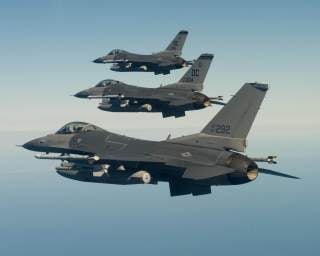What India Could Do with the F-16: Turn It into a 'Viper'
And cement a strong partnership with America.
The AESA radar will feeds its data into an enhanced avionics package, which includes a new pilot display, faster computer processors and super-high-speed data links, granting the ability to fuse sensor data from friendly platforms.
Another feature of the Block 70 that was recently incorporated on U.S. Air Force F-16 is an Automatic Ground Collision Avoidance System, which will correct an Viper’s course upwards whenever a crash seems imminent. This could save the pilot’s life in the event of a blackout during a high-G maneuver, or if the pilot loses track of his or her position during a dogfight—a leading cause of fatal jet fighter accidents.
Another upgrade is the addition of Conformal Fuel Tanks bolted onto the F-16 airframe. The base F-16C model has combat radius of only about three hundred miles—which means it usually has to carry underwing drop tanks to get very far without depending on aerial refueling. However, drop tanks create additional drag, take up weapons hardpoints and increase an airplane’s radar signature. A conformal fuel tank, by contrast, is designed to hug the airframe so as to have minimal impact on drag and radar cross section as well as freeing up hardpoints. The conformal tanks designed for the F-16 bulge out from the upper mid-fuselage like muscled shoulders, and can carry an add an extra three thousand pounds of fuel on top of the seven thousand pounds a Viper can normally carry.
The new Indian F-16s would also come off the factory floor with another feature added to late-model F-16s: helmet-mounted sights that can cue targets for High Off Bore Sight missiles such as the AIM-9X. Basically, this means that Viper pilots no longer needs to have their plane pointed at the enemy to shoot at it. The pilot need only train his helmet-mounted sight at an enemy he can see, and the AIM-9X can zoom off at a potentially sharp angle to intercept it.
It’s less clear what the Block 70’s armament will comprise Beyond Visual Range warfare, which is expected to predominate in future aerial clashes now that missiles can target aircraft from dozens of miles away. Will India order the AIM-120 missiles used by the U.S. Air Force and its allies, or will the Block 70 F-16 be compatible with the domestic Astra long-range missiles? The Lockheed Martin website for the Block 70 emphasizes “weapons integration” of “country-unique” weapons, which implies an Indian F-16 might be adapted to locally preferred systems.
In any event, it remains to be seen whether the Indian military will choose the F-16 Block 70 over the Swedish JAS 39 Gripen-E, which is generally considered to be more advanced and cheaper to operate per flight hour, but is also significantly more expensive up front. Politically, there are both advantages and disadvantages to striking a deal with a global power such as the United States. The arrangement could strengthen India-U.S. defense ties—but New Delhi might also fear it could be subject to shifting political winds due to the relationship with Pakistan.
Regardless, the fact that India is seriously considering becoming the sole assembler of the F-16 going forward—an airplane type that will remain in service in the United States and across the world for many more years—is a good indicator as to the current drift of U.S. foreign policy in Asia.
Sébastien Roblin holds a master’s degree in conflict resolution from Georgetown University and served as a university instructor for the Peace Corps in China. He has also worked in education, editing and refugee resettlement in France and the United States. He currently writes on security and military history for War Is Boring.
Image: Three U.S. Air National Guard F-16 Fighting Falcons fly in formation in October 2010. Flickr / Lockheed Martin

